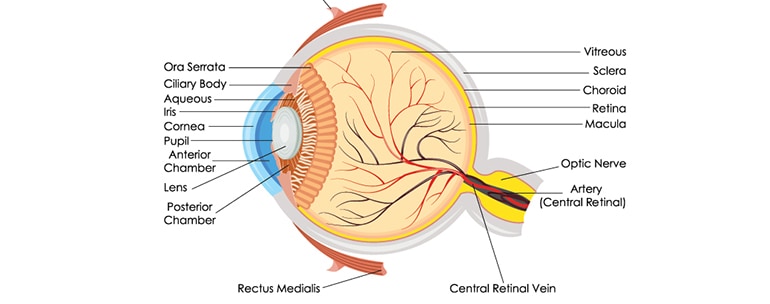The human eye is an amazing organ. It provides us with possibly the most important of our five senses, sight. Sight allows us to observe and learn about everything that surrounds us. Our eyes are used in almost every daily activity. Reading, working, writing or typing letters and e-mails, and driving are just a few. The vast majority of people would agree that sight is the most cherished of all the five senses. Eyes allow us to interpret colors, shapes and dimensions of objects, by processing the light which either emits from them, or bounces off them.
How Our Eyes Work
The light waves from any object enter the eye through the cornea first. The cornea is the clear cover at the front of the eye, and is similar to a window which allows light to pass through it. The light then goes through to the pupil, the small circular opening in the middle of the colored iris. The size of the pupil fluctuates depending on the amount of light going through it. As light enters through it, the pupil will constrict, or get smaller. When the light becomes dimmer, it will dilate, or get smaller.
The crystalline lens, which is located just behind the iris and the pupil, then bends the light to a point found behind the back of the lens. Here, the image is both reversed and inverted. The light continues through to the vitreous humor, a clear gel which comprises approximately 80% of our eyes volume. The light then goes back behind the vitreous humor, to the retina.
The center of the retina is called the macula. Once the light impulses are inside it, they are converted to electrical signals. These signals are sent through the optic nerve, and travel along the visual pathway. Their journey ends in the occipital cortex, which is found at the back of the brain. It is here that the signals will be processed and ‘seen’ by the brain. In essence, although the anatomy of the human eye is extremely complex, our eyes do not actually see. Our brains see the image, the eyes are merely the initial tools used in the process of sight.
Eye And Vision Problems
As complex and amazing as the anatomy of our eyes is, not everyone has perfect vision. If the incoming light from a faraway object is focused too early, ‘myopia’, or nearsightedness occurs. On the other hand, if the light from the same object is not focused by the time it reaches the back of the eye, ‘hyperopia’, or farsightedness occurs. As our eyes get older, like all the parts of the body, things break down and go wrong. Cataracts, problems with vision, and a host of other eye maladies can happen. Glasses, contact lenses, or surgery may even be required.
Of all the cataract doctors Fort Worth, Texas has to offer, one of the most skilled and well respected is Dr. Marvelli. If you are looking for an eye specialist and live in or near Fort Worth, call Dr. Marvelli for an appointment. 817-346-7333. The gift of sight is too important to trust to just anyone.


